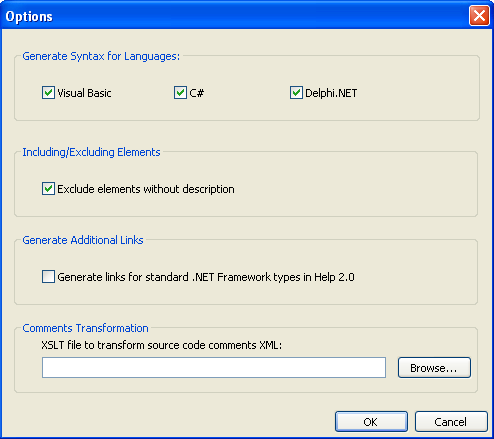Using Documenterís project Options dialog box, you can specify for which programming lanugages you want syntax automatically generated, whether to exclude elements that do not have descriptions provided in the assembly or XML file, and if you want links generated for standard .NET Framework types when building a Help 2.0 target.
To access the Options dialog box, in your Documenter project, select Options from the Project menu.

By default, Doc-To-Help automatically generates syntax for your reference section in Visual Basic and C# programming languages. You may want syntax generated for Delphi.NET as well or only in one language. Check the desired language(s) under Generate Syntax for Languages.
Documenter excludes elements without a description in the assembly or XML documentation file from the automatically generated reference document. To include all elements regardless of whether a description has been provided, uncheck the Exclude elements without description checkbox under Including/Excluding Elements.
Documenter automatically generates links for the standard .NET Framework classes and types, such as the System.String class, in Help 2.0 targets by default. When integrating your Help 2.0 targets with Microsoft Visual Studio, the links jump to the MSDN Help. If you do not plan to integrate your Help 2.0 Help file with Visual Studio, you must uncheck the Generate links for standard .NET Framework types in Help 2.0 under Generate Additional Links in the Options dialog box. Otherwise, when the Help 2.0 target is built, the links will be broken because they cannot jump to the MSDN Help since your Help 2.0 is not integrated.
If you want to use non-standard tags or attributes in your source code XML comments, you can create an XSLT transformation file (.XSLT) and attach it here under Comments Transformation. For more information, see Adding User-defined Tags and Attributes to XML Comments.